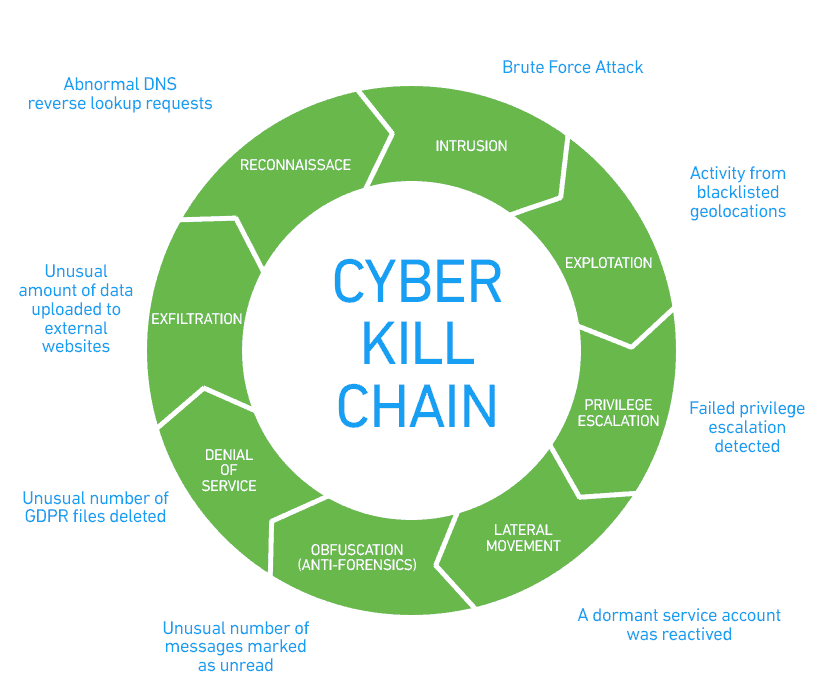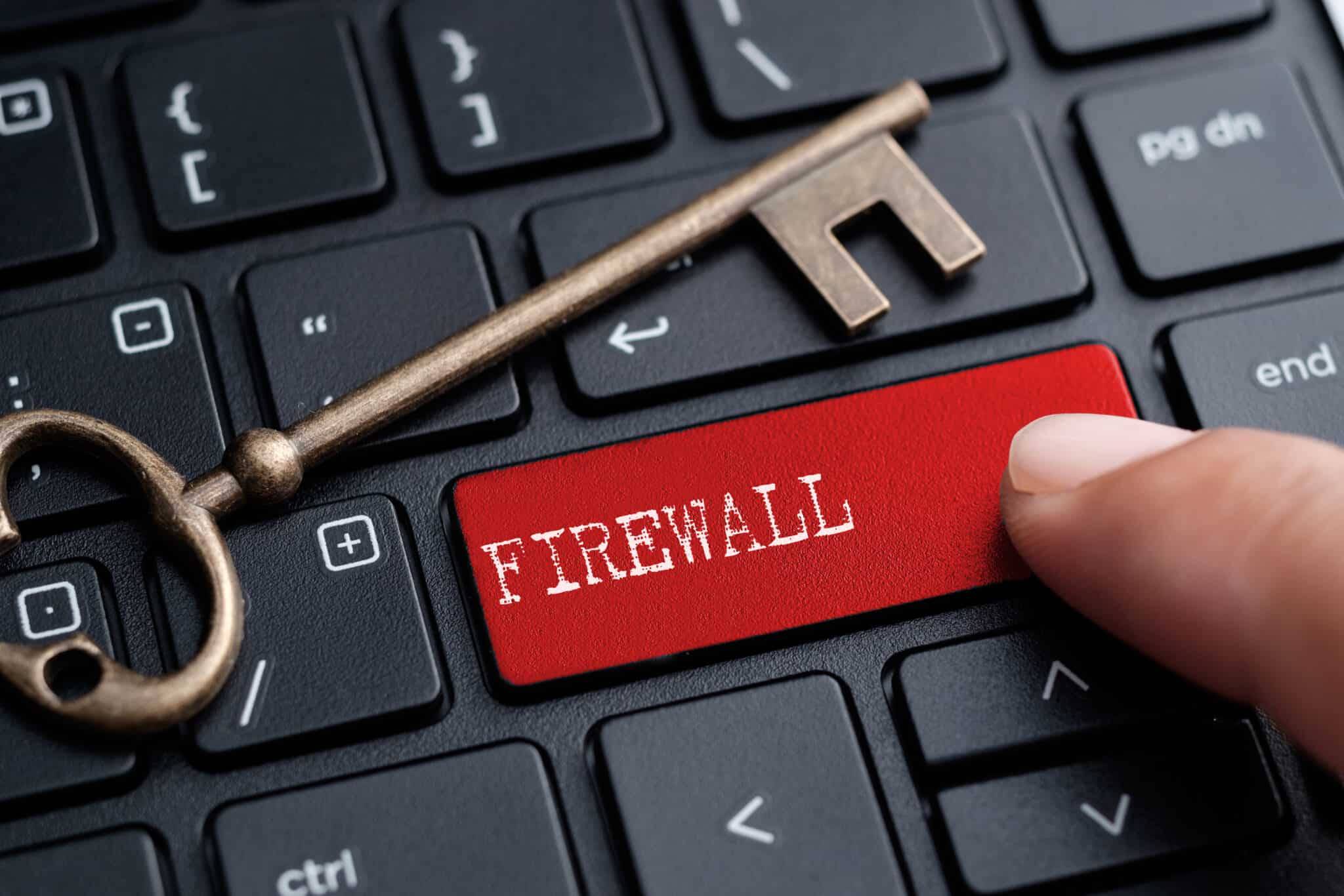
The Cyber Kill Chain was developed by Lockheed Martin to identify and prevent cyber intrusions. There are seven steps to the Cyber Kill Chain. Focusing on these steps helps analysts understand the techniques, tools, and procedures of threat actors. When responding to a security incident, the objective is to detect and stop the attack as early as possible in the kill chain progression. The earlier the attack is stopped; the less damage is done and the less the attacker learns about the target network.
The Cyber Kill Chain specifies what an attacker must complete to accomplish their goal.
The steps in the Cyber Kill Chain are shown in the figure.
Reconnaissance
Reconnaissance is when the threat actor performs research, gathers intelligence, and selects targets. This will inform the threat actor if the attack is worth performing. Any public information may help to determine the what, where, and how of the attack to be performed. There is a lot of publicly available information, especially for larger organizations including news articles, websites, conference proceedings, and public-facing network devices. Increasing amounts of information surrounding employees is available through social media outlets.
The threat actor will choose targets that have been neglected or unprotected because they will have a higher likelihood of becoming penetrated and compromised. All information obtained by the threat actor is reviewed to determine its importance and if it reveals possible additional avenues of attack.
The table summarizes some of the tactics and defenses used during the reconnaissance step.
| Adversary Tactics | SOC Defense |
|---|---|
| Plan and conduct research: Harvest email addresses Identify employees on social media Collect all public relations information (press releases, awards, conference attendees, etc.) Discover internet-facing servers Conduct scans of the network to identify IP addresses and open ports. | Discover adversary’s intent: Web log alerts and historical searching data Data mine browser analytics Build playbooks for detecting behavior that indicate recon activity Prioritize defense around technologies and people that reconnaissance activity is targeting |
Weaponization
The goal of this step is to use the information from reconnaissance to develop a weapon against specific targeted systems or individuals in the organization. To develop this weapon, the designer will use the vulnerabilities of the assets that were discovered and build them into a tool that can be deployed. After the tool has been used, it is expected that the threat actor has achieved their goal of gaining access into the target system or network, degrading the health of a target, or the entire network. The threat actor will further examine network and asset security to expose additional weaknesses, gain control over other assets, or deploy additional attacks.
It is not difficult to choose a weapon for the attack. The threat actor needs to look at what attacks are available for the vulnerabilities they have discovered. There are many attacks that have already been created and tested at large. One problem is that because these attacks are so well known, they are most likely also known by the defenders. It is often more effective to use a zero-day attack to avoid detection methods. A zero-day attack uses a weapon that is unknown to defenders and network security systems. The threat actor may wish to develop their own weapon that is specifically designed to avoid detection, using the information about the network and systems that they have learned. Attackers have learned how to create numerous variants of their attacks in order to evade network defenses.
The table summarizes some of the tactics and defenses used during the weaponization step.
| Adversary Tactics | SOC Defense |
|---|---|
| Prepare and stage the operation: Obtain an automated tool to deliver the malware payload (weaponizer). Select or create a document to present to the victim. Select or create a backdoor and command and control infrastructure. | Detect and collect weaponization artifacts: Ensure that IDS rules and signatures are up to date. Conduct full malware analysis. Build detections for the behavior of known weaponizers. Is malware old, “off the shelf” or new malware that might indicate a tailored attack? Collect files and metadata for future analysis. Determine which weaponizer artifacts are common to which campaigns. |
Delivery
During this step, the weapon is transmitted to the target using a delivery vector. This may be through the use of a website, removable USB media, or an email attachment. If the weapon is not delivered, the attack will be unsuccessful. The threat actor will use many different methods to increase the odds of delivering the payload such as encrypting communications, making the code look legitimate, or obfuscating the code. Security sensors are so advanced that they can detect the code as malicious unless it is altered to avoid detection. The code may be altered to seem innocent, yet still perform the necessary actions, even though it may take longer to execute.
The table summarizes some of the tactics and defenses used during the delivery step.
| Adversary Tactics | SOC Defense |
|---|---|
| Launch malware at target: Direct against web servers Indirect delivery through: Malicious email Malware on USB stick Social media interactions Compromised websites | Block delivery of malware: Analyze the infrastructure path used for delivery. Understand targeted servers, people, and data available to attack. Infer intent of the adversary based on targeting. Collect email and web logs for forensic reconstruction. |
Exploitation
After the weapon has been delivered, the threat actor uses it to break the vulnerability and gain control of the target. The most common exploit targets are applications, operating system vulnerabilities, and users. The attacker must use an exploit that gains the effect they desire. This is very important because if the wrong exploit is conducted, obviously the attack will not work, but unintended side effects such as a DoS or multiple system reboots will cause undue attention that could easily inform cybersecurity analysts of the attack and the threat actor’s intentions.
The table summarizes some of the tactics and defenses used during the exploitation step.
| Adversary Tactics | SOC Defense |
|---|---|
| Exploit a vulnerability to gain access: Use software, hardware, or human vulnerability Acquire or develop the exploit Use an adversary-triggered exploit for server vulnerabilities Use a victim-triggered exploit such as opening an email attachment or malicious weblink | Train employees, secure code, and harden devices: Employee security awareness training and periodic email testing Web developer training for securing code Regular vulnerability scanning and penetration testing Endpoint hardening measures Endpoint auditing to forensically determine origin of exploit |
Installation
This step is where the threat actor establishes a back door into the system to allow for continued access to the target. To preserve this backdoor, it is important that remote access does not alert cybersecurity analysts or users. The access method must survive through antimalware scans and rebooting of the computer to be effective. This persistent access can also allow for automated communications, especially effective when multiple channels of communication are necessary when commanding a botnet.
The table summarizes some of the tactics and defenses used during the installation step.
| Adversary Tactics | SOC Defense |
|---|---|
| Install persistent backdoor: Install webshell on web server for persistent access. Create point of persistence by adding services, AutoRun keys, etc. Some adversaries modify the timestamp of the malware to make it appear as part of the operating system. | Detect, log, and analyze installation activity: HIPS to alert or block on common installation paths. Determine if malware requires elevated privileges or user privileges Endpoint auditing to discover abnormal file creations. Determine if malware is known threat or new variant. |
Command and Control
In this step, the goal is to establish command and control (CnC or C2) with the target system. Compromised hosts usually beacon out of the network to a controller on the internet. This is because most malware requires manual interaction in order to exfiltrate data from the network. CnC channels are used by the threat actor to issue commands to the software that they installed on the target. The cybersecurity analyst must be able to detect CnC communications in order to discover the compromised host. This may be in the form of unauthorized Internet Relay Chat (IRC) traffic or excessive traffic to suspect domains.
The table summarizes some of the tactics and defenses used during command and control step.
| Adversary Tactics | SOC Defense |
|---|---|
| Open channel for target manipulation: Open two-way communications channel to CNC infrastructure Most common CNC channels over web, DNS, and email protocols CnC infrastructure may be adversary owned or another victim network itself | Last chance to block operation: Research possible new CnC infrastructures Discover CnC infrastructure though malware analysis Isolate DNS traffic to suspect DNS servers, especially Dynamic DNS Prevent impact by blocking or disabling CnC channel Consolidate the number of internet points of presence Customize rules blocking of CnC protocols on web proxies |
Actions on Objectives
The final step of the Cyber Kill Chain describes the threat actor achieving their original objective. This may be data theft, performing a DDoS attack, or using the compromised network to create and send spam or mine Bitcoin. At this point the threat actor is deeply rooted in the systems of the organization, hiding their moves and covering their tracks. It is extremely difficult to remove the threat actor from the network.
The table summarizes some of the tactics and defenses used during the actions on objectives step.
| Adversary Tactics | SOC Defense |
|---|---|
| Reap the rewards of successful attack: Collect user credentials Privilege escalation Internal reconnaissance Lateral movement through environment Collect and exfiltrate data Destroy systems Overwrite, modify, or corrupt data | Detect by using forensic evidence: Establish incident response playbook Detect data exfiltration, lateral movement, and unauthorized credential usage Immediate analyst response for all alerts Forensic analysis of endpoints for rapid triage Network packet captures to recreate activity Conduct damage assessment |




